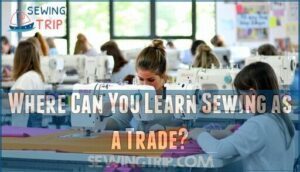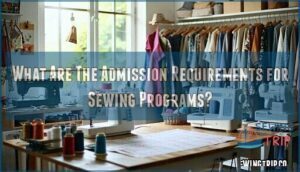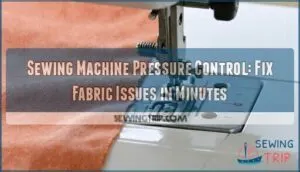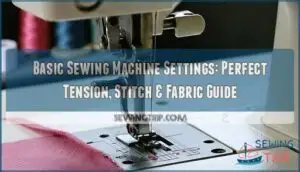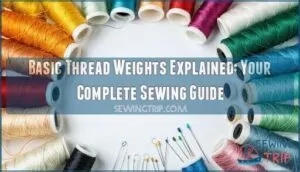This site is supported by our readers. We may earn a commission, at no cost to you, if you purchase through links.
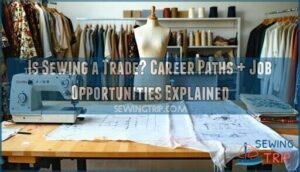 Yes, sewing is definitely a trade. You can master it through vocational schools, community colleges, or apprenticeships that teach everything from basic stitching to industrial machine operation.
Yes, sewing is definitely a trade. You can master it through vocational schools, community colleges, or apprenticeships that teach everything from basic stitching to industrial machine operation.
The field isn’t just about hemming pants anymore – you’ll find opportunities in fashion design, costume creation, alterations, upholstery, and manufacturing.
Many sewists work independently, running their own shops or freelancing for designers. Others land jobs in factories, theaters, or fashion houses.
It’s a hands-on skill that combines creativity with technical precision, and there’s real money to be made if you’ve got the talent and business sense. The secrets to turning your needle into serious income might surprise you.
Table Of Contents
- Key Takeaways
- What is Sewing as a Trade?
- Where Can You Learn Sewing as a Trade?
- What Skills Can You Gain From Sewing Programs?
- What Are The Admission Requirements for Sewing Programs?
- Where Can You Find Certificate Programs in Sewing?
- What Career Opportunities Are Available With a Certificate in Sewing?
- Frequently Asked Questions (FAQs)
- Conclusion
Key Takeaways
- You can learn sewing as a legitimate trade through vocational schools, community colleges, or apprenticeships – it’s officially recognized by the U.S. Department of Labor and doesn’t require a four-year degree.
- Multiple career paths await you, including fashion design, alterations, costume creation, upholstery, and industrial manufacturing, with salaries ranging from $32,500 to $66,401 annually.
- You’ll master both technical and creative skills through hands-on training that covers everything from basic stitching to advanced pattern drafting, fabric manipulation, and garment construction.
- You can start your own business or work for others – many sewers launch successful home-based operations, Etsy shops, or alteration services, while others find steady employment in fashion houses, theaters, or manufacturing facilities.
What is Sewing as a Trade?
Sewing has deep roots in our history, stretching back to the Palaeolithic era when humans first learned to join materials together.
Today, this skilled craft stands proudly as a recognized trade by the U.S. Department of Labor and the International Labour Organization.
You’re not just threading needles when you pursue sewing as a trade—you’re entering a field that combines technical precision with artistic expression. This textile art requires genuine skill development through vocational training, whether you choose apprenticeships, trade schools, or specialized programs.
Sewing transforms creative passion into professional mastery through skilled craftsmanship and technical expertise.
The sewing trade encompasses various occupations, from tailoring and dressmaking to industrial production. What sets it apart from hobbies is the professional-level expertise required. You’ll master complex techniques, understand fabric properties, and develop the keen eye for detail that separates craftspeople from casual sewers.
Unlike many careers requiring four-year degrees, sewing offers alternative pathways to success. This trade classification means you can build expertise through hands-on experience, making it accessible yet professionally rewarding for those seeking a sewing career. As sewists progress in their careers, they often focus on developing a strong sewing portfolio to showcase their skills and versatility.
Where Can You Learn Sewing as a Trade?
Learning opportunities abound when you’re ready to transform your creative passion into professional expertise. Community colleges across the country offer thorough sewing programs, from basic classes to advanced fashion design tracks.
You’ll find both credit and non-credit options, with many accepting out-of-state students for online courses. Trade colleges and vocational schools provide hands-on training that gets you job-ready fast.
Programs like those at Zaman International combine classroom learning with real-world apprenticeships, connecting you directly to employers. Vocational training typically spans 12 weeks and includes Department of Labor-approved certification paths.
Online courses offer flexibility for busy schedules. Schools like Penn Foster and Stratford Career Institute let you learn at your own pace while earning recognized credentials.
Don’t overlook community workshops and local sewing studios – they’re goldmines for practical skills and networking. Many offer specialized classes in upholstery or costume design.
Sewing apprenticeships through technical colleges provide the ultimate learn-while-you-earn experience, pairing you with seasoned professionals who’ll teach you trade secrets you won’t find in textbooks. Students can gain valuable experience through sewing training programs that focus on industrial sewing skills.
What Skills Can You Gain From Sewing Programs?
Professional sewing programs transform your creative instincts into marketable expertise through thorough skill development. You’ll master essential abilities that bridge artistry with technical precision.
By acquiring these skills, you can develop strong life skills foundations that benefit various aspects of your life.
- Sewing Techniques: Master fundamental to advanced stitches, seam finishing, and machine operation for professional-quality results across diverse fabric types.
- Pattern Drafting: Create custom patterns from scratch, modify existing designs, and understand garment fit through precise measurements and technical drawing.
- Fabric Manipulation: Learn draping, bias cutting, and textile handling techniques that transform flat materials into three-dimensional sculptural forms.
- Garment Construction: Develop systematic assembly skills including interfacing application, collar attachment, and structural reinforcement for durable clothing.
- Textile Knowledge: Understand fiber properties, fabric behavior, and material selection to make informed choices for specific projects and applications.
What Are The Admission Requirements for Sewing Programs?
Most sewing programs welcome beginners with open arms—no prior experience needed.
Program Eligibility typically requires a high school diploma or equivalent, though some vocational colleges accept students without formal credentials.
The Application Process is straightforward: submit basic information, transcripts, and sometimes a brief personal statement about your interest in sewing education.
Admission Tests aren’t common, but some textile design programs may require a portfolio or creativity assessment.
Sewing Prerequisites are minimal—just enthusiasm and basic hand-eye coordination.
Enrollment Requirements often include meeting with an advisor to discuss career goals and course selection.
Most programs operate on rolling admissions, so you can start when it works for your schedule.
Some technical schools offer evening or weekend classes for working adults.
Financial aid is typically available, making sewing education accessible to diverse backgrounds.
The beauty of sewing programs lies in their inclusivity—they’re designed to transform complete novices into skilled craftspeople through hands-on learning.
Understanding sewing as a career is essential for making informed decisions about education and training in the field.
Where Can You Find Certificate Programs in Sewing?
Finding the right certificate program opens doors to mastering this skilled trade.
You’ll discover options across multiple learning environments, each designed to fit different schedules and goals.
Technical Colleges like Bergen Community College offer structured programs combining classroom theory with hands-on practice.
These certificate programs prepare you for direct employment while building foundational skills.
Online courses provide flexibility for busy schedules.
Courses For Success delivers 150 hours of self-paced content, while Tailor Academy offers progressive masterclasses with success guarantees.
Vocational schools focus on industrial applications, covering machine operation and manufacturing techniques.
Local community classes through libraries and sewing workshops at independent studios create supportive learning environments.
Three Little Birds and Stitch Sew Shop offer beginner-friendly sessions.
Sewing training varies from basic sewing classes to specialized sewing courses in alterations or pattern development.
Whether you choose technical colleges or community workshops, you’ll find programs matching your career aspirations and learning preferences.
Many students benefit from exploring online sewing options to enhance their skills.
What Career Opportunities Are Available With a Certificate in Sewing?
Your sewing certification opens doors to diverse career paths across multiple industries. You’ll find opportunities in fashion design, where pattern makers earn an average of $66,401 annually translating creative visions into wearable art.
Your sewing certification unlocks creative careers spanning fashion design to custom tailoring across growing textile industries.
The fashion industry welcomes certificate holders as alterations specialists ($38,214 average salary) and custom tailors who serve clients needing perfect fits. Apparel manufacturing offers steady work as industrial sewing machine operators ($38,056 yearly) in production facilities.
If you’re drawn to storytelling through fabric, costume creation for theater, film, and cosplay conventions provides creative fulfillment and freelance flexibility. Textile jobs extend beyond the sewing machine.
You can become a merchandiser, fabric sales associate, or even start your own home-based business earning $32,500-$40,500 annually. Many certificate holders launch successful Etsy shops or offer specialized services like quilting and embroidery.
Understanding sewing careers list is vital for exploring the various paths available in the textile industry. Your sewing certification isn’t just about thread and needle—it’s your ticket to financial independence and creative expression in today’s growing textile market.
Frequently Asked Questions (FAQs)
How to make a career out of sewing?
Take Sarah, a home sewist who built a six-figure alteration business from her garage.
You’ll need training through trade schools or apprenticeships, then specialize in tailoring, costume design, or industrial sewing to launch your career.
What is cutting & sewing trade?
Cutting & sewing combines fabric preparation with garment construction.
You’ll cut patterns from textiles, then stitch pieces together using machines or hand-sewing techniques to create finished clothing, home goods, or industrial products, which involves complete concepts of garment making.
What is sewing & why is it important?
You’ve likely heard that handmade clothing lasts longer—it’s true.
Sewing transforms fabric into personalized garments while teaching patience, precision, and problem-solving.
It’s sustainable fashion that saves money long-term and builds confidence through creating something uniquely yours.
Can sewing be a new career?
Yes, you can absolutely turn sewing into a thriving career!
With over 150 job opportunities in textiles, from fashion design to industrial operations, skilled sewers are in demand.
Start building your portfolio today.
What is a sewing career?
Despite what some think, sewing isn’t just a hobby—it’s a legitimate career path.
You’ll find work as tailors, fashion designers, industrial operators, or costume creators, blending technical skills with creativity for steady employment.
Can a sewist sew with a machine or by hand?
You’ve got the freedom to choose your weapon – whether it’s the precision of a sewing machine or the meditative rhythm of hand-stitching, both paths lead to creating something amazing.
Is sewing a trade skill?
Threading through your career options? You’ve struck gold!
Sewing is officially recognized as a skilled trade by the U.S. Department of Labor, offering hands-on expertise that transforms fabric into opportunity through technical training.
What is sewing classified as?
Sewing’s classified as a skilled trade by the U.S. Department of Labor and recognized internationally.
You’ll find it taught in vocational schools alongside electrical work and plumbing, requiring specialized training rather than traditional college degrees.
Is sewing a good trade?
Like finding your golden thread, sewing’s an excellent trade offering creative freedom, steady income potential, and diverse career paths. You’ll master technical skills while building something tangible, meaningful.
Is tailoring a service or trade?
Tailoring is both a service and a trade.
You’re providing a skilled service when you alter someone’s clothes, but you’re practicing a recognized trade requiring technical expertise, training, and craftsmanship to master.
Conclusion
Skillfully stitching your way to success, is sewing a trade that offers genuine career potential.
You’ve got multiple paths ahead—from running your own alteration shop to joining theater costume teams.
The combination of creative expression and technical expertise makes this field particularly rewarding.
Whether you’re drawn to fashion design, upholstery work, or manufacturing, your needle skills can translate into steady income.
With proper training and business savvy, you’ll transform a beloved hobby into a profitable profession that keeps growing.

